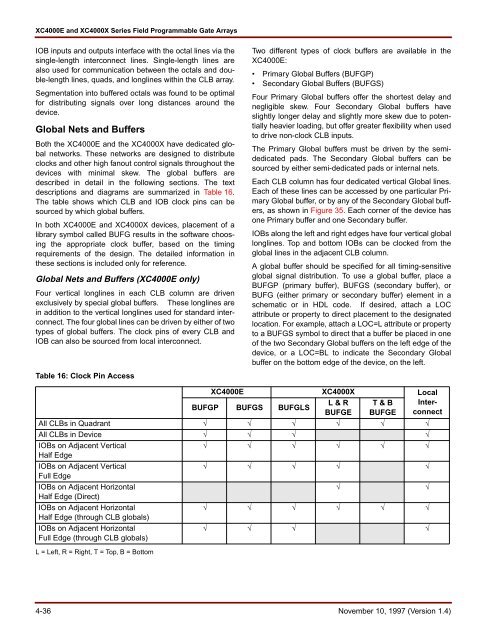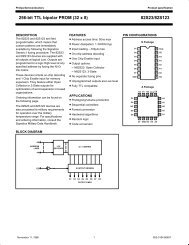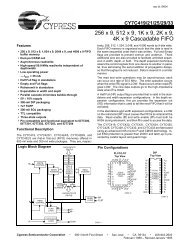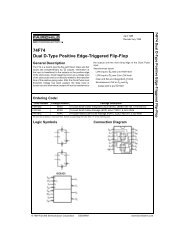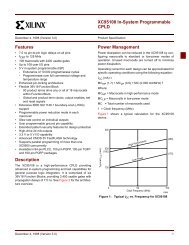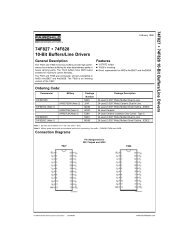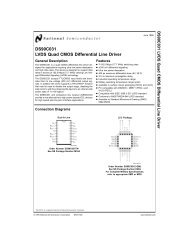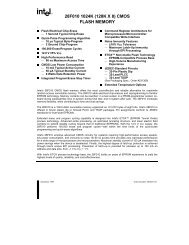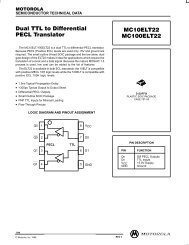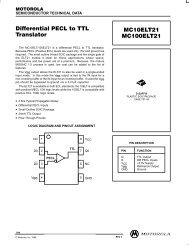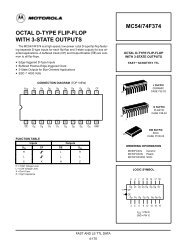Xilinx 4000-series FPGAs
Xilinx 4000-series FPGAs
Xilinx 4000-series FPGAs
You also want an ePaper? Increase the reach of your titles
YUMPU automatically turns print PDFs into web optimized ePapers that Google loves.
XC<strong>4000</strong>E and XC<strong>4000</strong>X Series Field Programmable Gate ArraysIOB inputs and outputs interface with the octal lines via thesingle-length interconnect lines. Single-length lines arealso used for communication between the octals and double-lengthlines, quads, and longlines within the CLB array.Segmentation into buffered octals was found to be optimalfor distributing signals over long distances around thedevice.Global Nets and BuffersBoth the XC<strong>4000</strong>E and the XC<strong>4000</strong>X have dedicated globalnetworks. These networks are designed to distributeclocks and other high fanout control signals throughout thedevices with minimal skew. The global buffers aredescribed in detail in the following sections. The textdescriptions and diagrams are summarized in Table 16.The table shows which CLB and IOB clock pins can besourced by which global buffers.In both XC<strong>4000</strong>E and XC<strong>4000</strong>X devices, placement of alibrary symbol called BUFG results in the software choosingthe appropriate clock buffer, based on the timingrequirements of the design. The detailed information inthese sections is included only for reference.Global Nets and Buffers (XC<strong>4000</strong>E only)Four vertical longlines in each CLB column are drivenexclusively by special global buffers. These longlines arein addition to the vertical longlines used for standard interconnect.The four global lines can be driven by either of twotypes of global buffers. The clock pins of every CLB andIOB can also be sourced from local interconnect.Table 16: Clock Pin AccessTwo different types of clock buffers are available in theXC<strong>4000</strong>E:• Primary Global Buffers (BUFGP)• Secondary Global Buffers (BUFGS)Four Primary Global buffers offer the shortest delay andnegligible skew. Four Secondary Global buffers haveslightly longer delay and slightly more skew due to potentiallyheavier loading, but offer greater flexibility when usedto drive non-clock CLB inputs.The Primary Global buffers must be driven by the semidedicatedpads. The Secondary Global buffers can besourced by either semi-dedicated pads or internal nets.Each CLB column has four dedicated vertical Global lines.Each of these lines can be accessed by one particular PrimaryGlobal buffer, or by any of the Secondary Global buffers,as shown in Figure 35. Each corner of the device hasone Primary buffer and one Secondary buffer.IOBs along the left and right edges have four vertical globallonglines. Top and bottom IOBs can be clocked from theglobal lines in the adjacent CLB column.A global buffer should be specified for all timing-sensitiveglobal signal distribution. To use a global buffer, place aBUFGP (primary buffer), BUFGS (secondary buffer), orBUFG (either primary or secondary buffer) element in aschematic or in HDL code. If desired, attach a LOCattribute or property to direct placement to the designatedlocation. For example, attach a LOC=L attribute or propertyto a BUFGS symbol to direct that a buffer be placed in oneof the two Secondary Global buffers on the left edge of thedevice, or a LOC=BL to indicate the Secondary Globalbuffer on the bottom edge of the device, on the left.XC<strong>4000</strong>E XC<strong>4000</strong>X LocalBUFGP BUFGS BUFGLSL & R T & B InterconnectBUFGE BUFGEAll CLBs in Quadrant √ √ √ √ √ √All CLBs in Device √ √ √ √IOBs on Adjacent Vertical√ √ √ √ √ √Half EdgeIOBs on Adjacent Vertical√ √ √ √ √Full EdgeIOBs on Adjacent Horizontal√√Half Edge (Direct)IOBs on Adjacent Horizontal√ √ √ √ √ √Half Edge (through CLB globals)IOBs on Adjacent HorizontalFull Edge (through CLB globals)√ √ √ √L = Left, R = Right, T = Top, B = Bottom4-36 November 10, 1997 (Version 1.4)


